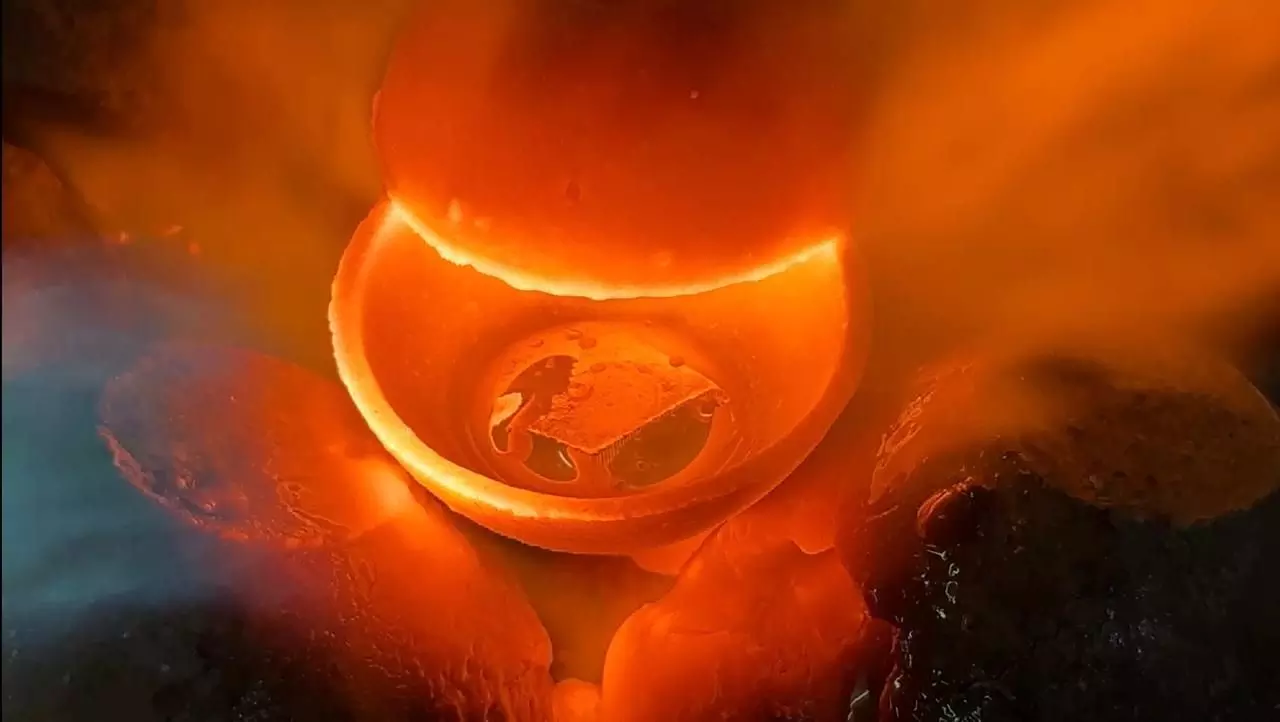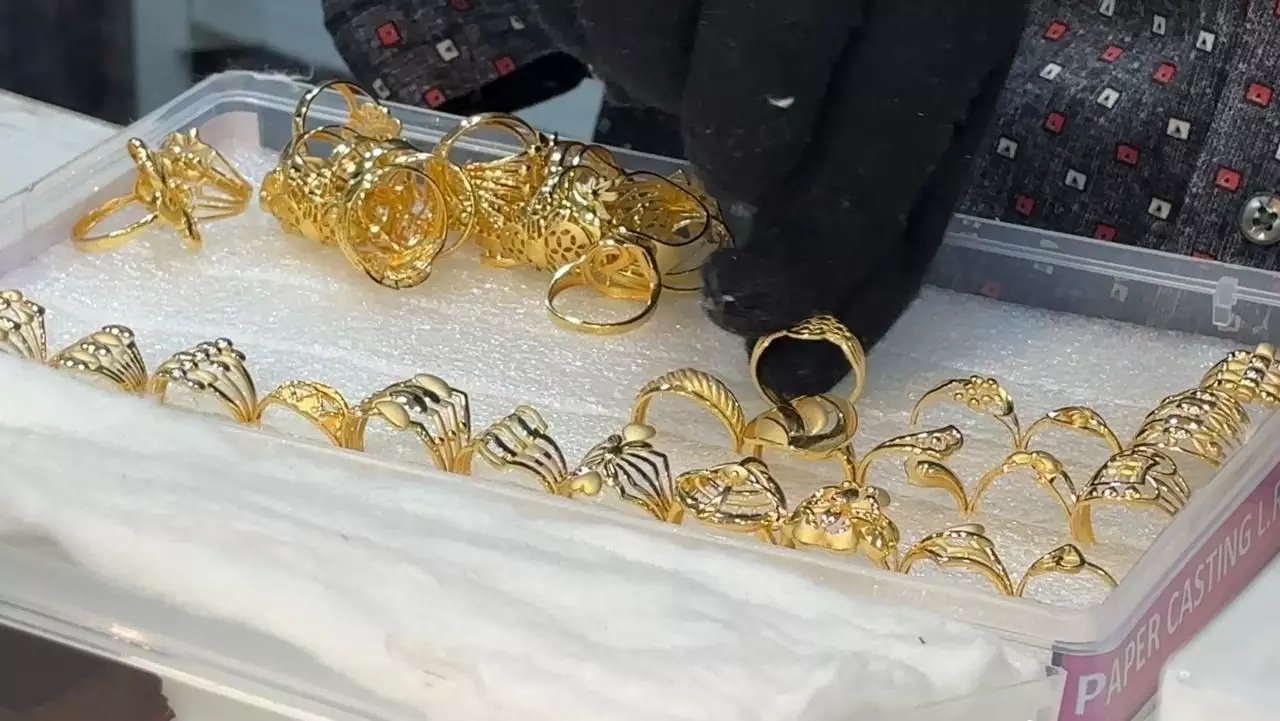
- Home
- India
- World
- Premium
- THE FEDERAL SPECIAL
- Analysis
- States
- Perspective
- Videos
- Sports
- Education
- Entertainment
- Elections
- Features
- Health
- Business
- Series
- In memoriam: Sheikh Mujibur Rahman
- Bishnoi's Men
- NEET TANGLE
- Economy Series
- Earth Day
- Kashmir’s Frozen Turbulence
- India@75
- The legend of Ramjanmabhoomi
- Liberalisation@30
- How to tame a dragon
- Celebrating biodiversity
- Farm Matters
- 50 days of solitude
- Bringing Migrants Home
- Budget 2020
- Jharkhand Votes
- The Federal Investigates
- The Federal Impact
- Vanishing Sand
- Gandhi @ 150
- Andhra Today
- Field report
- Operation Gulmarg
- Pandemic @1 Mn in India
- The Federal Year-End
- The Zero Year
- Science
- Brand studio
- Newsletter
- Elections 2024
- Events
Festive buying to wedding shopping, why the middle class is struggling to purchase gold jewellery
The skyrocketing gold price has made the yellow metal a more attractive investment option than a jewellery choice for the middle class. Despite coming Diwali-Dhanteras and wedding season, demand for ornaments sees a dip, with buying mostly restricted to lightweight pieces

It’s that time of the year again, when the approaching Dhanteras-Diwali festivities, with the wedding season round the corner, see crowds forming at jewellery stores across India. The reasons vary, some may buy for shagun (good luck) during the festival, others for an approaching wedding in the family, or to gift to a near and dear one, but unlike those regularly investing in gold, this...
It’s that time of the year again, when the approaching Dhanteras-Diwali festivities, with the wedding season round the corner, see crowds forming at jewellery stores across India. The reasons vary, some may buy for shagun (good luck) during the festival, others for an approaching wedding in the family, or to gift to a near and dear one, but unlike those regularly investing in gold, this period sees many middle-class buyers making purchases with money saved through the year for this occasion.
No wonder then that the skyrocketing gold prices — rates hit a historical milestone of $4,000 per ounce, or over Rs 1.2 lakh per 10 grams, the highest ever, earlier this week — has become a topic of both conversation and concern.
Sanjana Kaur, a West Delhi resident, out shopping for her daughter’s wedding, was one of those left disheartened by the prices. “I had planned to purchase some nice pieces, but prices have gone up so much that I can only afford light jewelry now. Buying gold was not this difficult in the past.”
Sangeeta, a resident of Delhi’s Rohini area, who identified herself by first name only, voiced similar worry. “My son’s wedding is coming up, so I have to buy gold — it’s a compulsion now, not a choice. Prices are sky-high, but we’re adjusting and buying smaller pieces.”
Generations of Indians, who have considered the gold gifted to their women at marriage as ‘stree dhan’ or an asset for her, are struggling to keep up with traditions.
This has also left jewellers concerned. While the high prices may offset monetary loss, the volume of business has taken a dip, say jewellers The Federal spoke to. “This time, gold has gone completely beyond the reach of the common man. Orders have dropped by about 40 per cent. Prices were high earlier, too, but this time, gold has become unexpectedly expensive. For ordinary people, even buying wedding jewelry has become difficult,” said RP Singh, a jeweller in Delhi’s Karol Bagh area.
Shri Ram Hari Ram Jewellers, a nearly 250-year-old shop in Dariba, in the national capital’s old quarters of Chandni Chowk, claims to have once been jeweller to India’s last Mughal emperor, Bahadur Shah Zafar. The current owner of the shop, Mahesh Gupta, said, “These days, there are fewer jewellery customers and more buyers for gold coins and biscuits. That clearly shows most current buyers are investors. The average jewellery buyer is either avoiding gold or opting for lightweight jewelry.”
He added: “The usual excitement around Diwali and Dhanteras is missing this year. It seems people [non-investors] will keep their distance from gold and silver. The wedding season may bring some sales, but they’ll be limited — people will buy only what’s absolutely necessary.”
Also read: How a nondescript Odisha village has found identity with a weekly haat for Sambalpuri sarees
Despite Diwali and Dhanteras being just over a week away, jewellers and goldsmiths say the usual festive rush is lacking this year. According to their estimates, at present festive buying is seeing a 40 per cent dip as compared to last year. Gold prices during Diwali-Dhanteras last year were approximately Rs 80,000 per 10 grams, they recall. A far cry from the current rate of over a lakh. According to industry insiders, the rise in prices has been especially steep in the past eight months. From hovering around Rs 8,193 per gram in January and Rs 8,869 per gram the next month, the price of 24 karat gold touched Rs 12,458 per gram on Thursday (October 9).

Jewellery manufacturing unit at RP Bangles, Delhi. Photo by Nadim Ahmad
“There are quite a few reasons for the hike that we are witnessing in gold prices,” said economist and financial advisor Sharad Kohli. “First is relentless buying by central banks across the world. Ever since Donald Trump waged his tariff war against countries, central banks have been feeling geopolitical uncertainty and are selling investments in the US treasury and buying gold. Interest rate cuts by the US Federal Reserve and weakening of the US dollar are other contributors,” he added.
The other big reason for gold prices to soar, according to Kohli, “is the prevalent geopolitical uncertainty, aggravated by the Russia-Ukraine war, which it is now being feared may escalate into World War III because of tensions between NATO and Russia”.
Yogesh Singhal, president of the All India Bullion and Jewellers Association, too cited a global policy shift to reduce dependency on the US dollar and strengthening gold reserves instead, as the main reason for the price hike. “Banks and investors across the world — including in Europe and Russia — are increasing their gold holdings, which is driving prices up internationally,” he said. Singhal recalled a similar situation in 2013, “when gold prices skyrocketed before falling by about 43 per cent”. Those who invested without careful thought suffered losses. “The way gold prices are rising now is hard to comprehend. If investors and ordinary people start panic buying, it could spell trouble for the market. Gold should be bought as an investment — but only within one’s personal budget and needs,” he cautioned.
Kohli too advises investors to buy gold in smaller amounts and not to get carried away by the price hike. According to him, only about 20-25 per cent of one’s investment portfolio should comprise gold and silver.
Also read: Osmania biscuit: How Hyderabad’s popular tea-time snack got the Nizam’s name
Another segment that is likely to benefit from the gold price hike is those seeking loans against gold, with the higher valuation potentially allowing borrowers to seek larger loans against the same gold, say experts. The Indian Credit Rating Company (ICRA) has reportedly addressed a growth in the country’s organised loan market. Recent ICRA projections expect the sector to touch Rs 15 trillion in 2025-26, a year earlier than past estimates, claimed news reports. The Federal has reached ICRA chief economist, Aditi Nayar, for comment. The article will be updated once a response is received.

Gold rings at a showroom in Delhi. Photo by Nadim Ahmad
Meanwhile, as middle-class occasion buyers feel the pinch, jewellers are trying to adapt their designs to suit their limited purchasing powers. While one jewellery brand has announced plans to introduce 9-carat gold jewellery, to make gold affordable for the common man, another trend is one-gram jewellery — ornaments that purportedly have a layer of one gram of 24-carat gold over a base of metals like brass or copper.
“Locally, we call this process sona chadhana (gold covering). If a piece has micro-plating of 1 gram of gold, its shine lasts for about three to four years. But in reality, most sellers don’t even use a full gram of gold,” claimed RP Singh.
Jewellers are also leaning on strategy to dull the force of the metal’s exorbitant price for sellers; where traditionally, gold price has been displayed in terms of rupees per ten grams, many showrooms are now exhibiting per-gram prices, as a psychological tool to make it appear cheaper than it is.
Also read: Kolhapuri Saaj: How this handcrafted gold necklace keeps a city’s heritage alive
For those with fixed means, however, such tactics bring little comfort.
“We wanted to buy a piece of jewellery for our daughter,” said a shopper, who didn’t want to be named. “But the prices were so high that we could only buy gold as a small investment. Gifting gold jewellery is becoming increasingly difficult.” With jewellery becoming an inaccessible luxury for many, at stores, buyers, unless forced to purchase for an upcoming marriage in the family, are settling for tokenism — small gold coins, for investment and luck.
